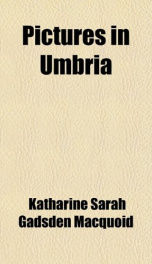pictures in umbria

Purchase of this book includes free trial access to www.million-books.com where you can read more than a million books for free. This is an OCR edition with typos. Excerpt from book: CHAPTER III FONTE DI PERUGIA next morning we took our way up a side turning into the Corso, the handsomest street in Perugia. The shop windows had the day before NICOLO PISANO. been made extra gay, to attract the market-sellers; they still showed long strings of cut coral beads. There is a mass of fine, as well as interesting, fourteenth century building on the left of the Corso : the Collegio del Cambio, and the Palazzo del Pubblico, or, as it is also called, Palazzo Comunale. This has a richly - sculptured doorway, and ends on the Piazza del Duomo; it has quaint iron lamps. On this Piazza, and facing us, we saw the un- finished stone and brick work of the Cathedral, San Lorenzo, with its outside pulpit, from which St. Bernardino preached to the people. On the left stands the Palace called the Canonica or Seminary, with its cloisters. This belonged to the clergy, and was the dwelling of those Popes who stayed in Perugia during their visits to the city, so greatly beloved and coveted by the Holy See. In the centre of the Piazza, stands the famous fountain usually ascribed to Nicolo Pisano, but said to have been designed by Fra Bevignate, a native of the city. However, the great Pisan sculptor and his son Giovanni made the two large marble basins, and sculptured the panels which decorate them. Nicolo, whose quaint costume is given in the initial, is said to have sculptured the twenty-four statues, now dark with age, but remarkable for the sharpness of their exquisite carving ; two of the statues are, however, restorations. The delicate bas-reliefs of the second basin are ascribed to Giovanni Pisano, and are full of variety ; the upper basin, with nymphs and lions and the inevitable griffin of Perugia, is supposed to have been cast in bronze by Rossi; w...
Info about the book
Author:
Series:
Unknown
ISBN:
1273623983
Rating:
5/5 (3)Your rating:
0/5
Languge:
English
Users who have this book
Users who want this book
What readers are saying
What do you think? Write your own comment on this book!
write a commentif you like pictures in umbria try:
Other books by this author
Do you want to exchange books? It’s EASY!
Get registered and find other users who want to give their favourite books to good hands!

